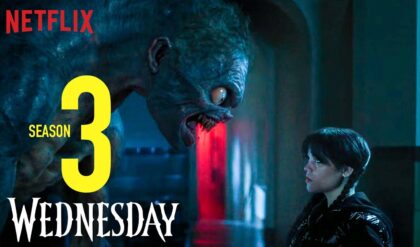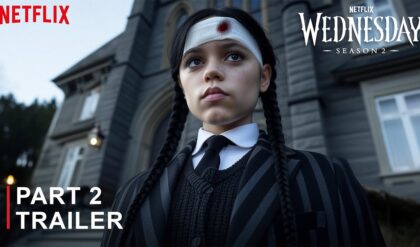HBO’s upcoming Harry Potter television series, set to reimagine J.K. Rowling’s beloved wizarding world for a new generation, has ignited a firestorm of debate with its casting choices. Among the most polarizing is the decision to cast Paapa Essiedu, a acclaimed Black British actor, as Severus Snape, a character historically depicted as pale and sallow-skinned in Rowling’s books. This choice, confirmed by HBO in April 2025, has sparked intense discussions about how it reshapes one of the series’ core dynamics: the rivalry between Snape and James Potter, Harry’s father. By introducing a racial dimension to their conflict, the reboot risks transforming James from a flawed but redeemable hero into a figure some fans may see as irredeemably unlikeable. This 1500-word article explores the implications of Essiedu’s casting, the new layers it adds to the Snape-Potter feud, and why this bold move has both excited and divided the Harry Potter fandom.

A New Snape for a New Era
Severus Snape, the potions master of Hogwarts and one of the most complex characters in Rowling’s saga, has long been a fan favorite. His journey from a bitter, seemingly cruel teacher to a tragic anti-hero, driven by unrequited love and guilt, captivated readers and viewers alike. In the original film series, Alan Rickman’s iconic portrayal cemented Snape as a brooding, sharp-tongued figure with a distinctive gaunt appearance. Essiedu, known for his dynamic performances in I May Destroy You and The Lazarus Project, brings a different energy to the role. At 34, he aligns more closely with Snape’s canonical age of 31 in Harry Potter and the Sorcerer’s Stone, but his casting as a Black actor marks a significant departure from the book’s description of Snape’s “marble white” skin.
HBO has promised a “faithful adaptation” of Rowling’s novels, yet Essiedu’s casting reflects a commitment to diversity that has characterized recent adaptations of legacy franchises. The decision has been met with both praise and criticism. Supporters argue that Essiedu’s talent and emotional depth make him an ideal choice to capture Snape’s tormented psyche, while detractors contend that altering Snape’s race introduces unintended narrative complications. Chief among these is the reframing of his rivalry with James Potter, a dynamic that lies at the heart of Snape’s backstory and Harry’s legacy.
The Snape-Potter Rivalry: A Classic Tale of Enmity
In Rowling’s books, the animosity between Snape and James Potter is rooted in their time as Hogwarts students in the 1970s. James, a popular, wealthy pure-blood wizard, and his friends—Sirius Black, Remus Lupin, and Peter Pettigrew—relentlessly bullied Snape, a poor, half-blood outcast with an interest in the Dark Arts. Their conflict was fueled by class differences, personal grudges, and Snape’s unrequited love for Lily Evans, James’s future wife. Key moments, such as James humiliating Snape by levitating him upside-down in front of peers, paint James as a privileged tormentor, though later revelations about his growth and heroism soften his image.
This rivalry shapes Snape’s resentment toward Harry, whom he sees as a living reminder of James. It also underscores Snape’s outsider status, as his “sallow” appearance and greasy hair mark him as an object of scorn in a world that values charisma and pedigree. The books frame the conflict as a schoolyard feud with moral ambiguity: James’s actions are cruel, but Snape’s descent into the Death Eaters suggests his own flaws. The HBO reboot, however, introduces a new lens through which to view this dynamic, one that could alter its emotional and thematic weight.
A Racial Lens on Bullying: James Potter’s New Image
With Essiedu cast as Snape, the bullying scenes between a Black Snape and a presumably white James Potter (whose casting has not yet been announced) take on a charged racial subtext. In the books, James’s taunts target Snape’s appearance and social status, but they do not explicitly involve race. Now, the image of a privileged white student targeting a Black peer in a predominantly white institution like Hogwarts risks evoking real-world issues of racial prejudice and systemic exclusion. This shift could make James’s actions appear not just cruel but potentially discriminatory, casting him as a “toxic jock” rather than a misguided teenager who later matures.
Fans have taken to platforms like X to voice their concerns, with some arguing that this change distorts the original narrative. One user noted that James’s bullying, while indefensible, was not racially motivated in the books, and introducing this element could oversimplify a complex character arc. Others fear that it risks vilifying James to an extent that undermines his legacy as Harry’s heroic father. After all, James’s growth into a man who sacrifices his life for his family is a cornerstone of the series’ emotional resonance. If his youthful cruelty is perceived as racially charged, it may be harder for audiences to forgive him, even with the context of his redemption.
Conversely, some fans see this as an opportunity to deepen the story’s relevance. The Harry Potter series has often been interpreted as an allegory for prejudice, with its themes of blood purity mirroring real-world racism. A Black Snape could amplify these parallels, highlighting how societal biases shape personal conflicts. Essiedu’s casting might allow the show to explore Snape’s marginalization through a modern lens, drawing parallels to the experiences of minority groups in elite institutions. This approach could resonate with younger audiences, who are more attuned to discussions of race and power dynamics.
The Narrative Risks and Rewards
The decision to cast Essiedu is not without precedent. Rowling herself supported the casting of Noma Dumezweni as Hermione in the stage play Harry Potter and the Cursed Child, dismissing critics as “a bunch of racists.” Yet, Snape’s role is uniquely fraught. Unlike Hermione, whose race is not central to her story, Snape’s outsider status is tied to specific traits—poverty, mixed blood, and physical unattractiveness—that could be overshadowed by racial dynamics. For instance, Snape’s alignment with the Death Eaters, a group obsessed with blood purity, takes on new implications if he is Black. His motivations—anger, rejection, and a desire for power—might be interpreted as responses to racial injustice rather than personal failings, potentially flattening his moral complexity.
The show’s creative team, led by showrunner Francesca Gardiner and director Mark Mylod, faces the challenge of navigating these nuances. The extended format of a TV series offers more room to explore Snape’s backstory, potentially addressing how his race shapes his experiences without reducing him to a victim of prejudice. For example, the show could depict Hogwarts as a microcosm of societal biases, where Snape faces subtle slights from peers and teachers alike. Such an approach would require careful writing to avoid heavy-handed messaging that alienates fans who value the books’ subtlety.
On the reward side, Essiedu’s casting could breathe fresh life into Snape’s character. His proven ability to portray layered, conflicted figures suggests he can capture Snape’s duality—his cruelty toward Harry and his hidden loyalty to Dumbledore’s cause. A younger, more dynamic Snape might also make the character’s tragic love for Lily more palpable, grounding his actions in raw emotion rather than the weary bitterness of Rickman’s older portrayal. If handled well, this reinvention could make Snape a standout figure in the reboot, appealing to both longtime fans and newcomers.
Fan Reactions: A Fandom in Turmoil
The announcement of Essiedu’s casting has unleashed a torrent of reactions across social media. On X, sentiments range from enthusiastic support to outright rejection. Some fans praise HBO for its bold vision, with one user writing, “Paapa Essiedu as Snape is a game-changer. He’ll bring a fresh intensity to the role, and I’m here for it.” Others, however, feel the casting betrays the source material, with comments like, “Snape’s story isn’t about race. This feels like HBO forcing a modern agenda into a story that doesn’t need it.” A vocal subset has expressed concern for Essiedu himself, noting the toxic backlash Black actors often face in high-profile roles, as seen with Dumezweni and others.
The debate has also reignited discussions about Rowling’s involvement as an executive producer. Her controversial views on transgender issues have already alienated some fans, and Essiedu’s casting has been interpreted by some as an attempt to “rehabilitate” the franchise’s image. Whether this move will win over skeptical viewers or further polarize the fandom remains to be seen. What’s clear is that the reboot is shaping up to be a cultural lightning rod, with every casting decision scrutinized for its narrative and political implications.
James Potter’s Legacy: Hero or Villain?
The reframing of James Potter’s rivalry with Snape poses a particular challenge for the reboot’s portrayal of Harry’s father. In the books, James is a polarizing figure: a bully in his youth but a courageous man who dies protecting his family. The films softened his flaws, focusing on his heroism, but the TV series, with its promise of deeper exploration, may lean into his darker side. A racially charged conflict with Snape could tip the scales, making it harder for audiences to see James as a flawed but ultimately good man. This, in turn, could affect how viewers perceive Harry, whose identity is so tied to his parents’ legacy.
To mitigate this, the show could emphasize James’s growth, perhaps through new scenes showing his remorse or efforts to change. Alternatively, it could frame his bullying as a product of youthful ignorance rather than malice, though this risks downplaying the seriousness of his actions. The casting of James Potter will be crucial in this regard. An actor who can convey charisma, vulnerability, and regret will be essential to preserving James’s complexity.
Looking Ahead: A Reboot Under Pressure
HBO’s Harry Potter series, slated for a 2026 or 2027 premiere, carries immense expectations. With a cast that includes John Lithgow as Dumbledore, Janet McTeer as McGonagall, and Nick Frost as Hagrid, the show is assembling a formidable ensemble. Yet, Essiedu’s casting as Snape has placed it at the center of a cultural maelstrom. The decision to reimagine such an iconic character reflects HBO’s willingness to take risks, but it also underscores the challenges of adapting a beloved story in an era of heightened social awareness.
As filming begins, the creative team must balance fidelity to Rowling’s vision with the need to resonate with a diverse, modern audience. Essiedu’s Snape has the potential to be a defining feature of the reboot, offering a fresh perspective on a character who has captivated fans for decades. However, the shadow of James Potter’s newly complicated rivalry looms large, threatening to reshape how viewers see one of the series’ foundational figures. Whether this bold casting choice elevates the story or fractures its legacy, it has already ensured that HBO’s Harry Potter reboot will be one of the most talked-about projects in years.





